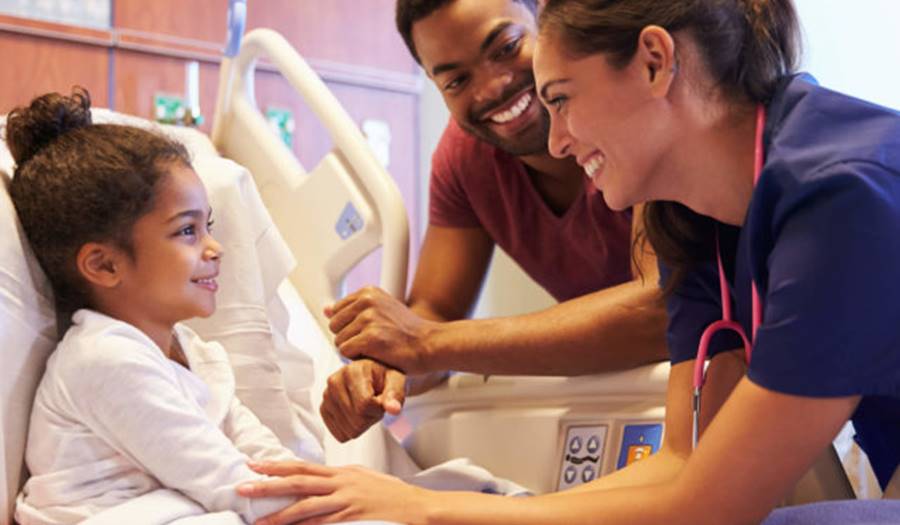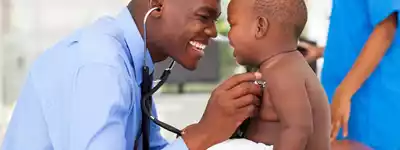
Medical Visits And Your Child
6/21/2021
How to prepare your child for office visits and medical procedures
Children come into our offices for routine physical exams, visits due to illness or injury, and to monitor chronic health issues. Despite being a frequent presence in your child’s life, a visit to the pediatrician can be fear inducing for your child. Sometimes children require the care of a specialist for an illness or injury. These visits may include medical procedures that can be frightening. And children who are frightened may act in ways that make these tests harder to perform safely and correctly.
As we learned in the behavior blog series, behavior is a result of an emotion, we can help mitigate some of the fear towards office visits and procedures by preparing your child. Today we will learn more about preparing your child for a visit, for certain common medical procedures, and learn about resources at children’s hospitals.
VISIT AND PROCEDURE PREPARATION
There are three elements of preparing children for a medical procedure. The first is that you should present developmentally and age-appropriate information in a manner that is easy for your child to understand. You should discuss the procedure, the providers, and prepare them for what they may feel, smell, hear, or taste. You also want to let them know what their “job” will be during the procedure. It is comforting for a child to know what will be expected of them. This prep work should include discussion but can include videos, books, and pictures. You can find book suggestions HERE. Children's Hospital of Philadelphia has a helpful video you can watch in the link.
Next your child should be able to ask any question about the visit or procedures. They should also be able to express any fears or concerns. Children have big imaginations and big feelings. If your child is able to ask all their questions, you can clarify any misconceptions. If they are able to express their emotions and concerns, they feel validated and often are better able to cope during the visit or procedure.
And the third is where we come in! We need to build a trusting relationship with you and your child. We hope that we do this at every visit. We try to talk to your child, explain things so that they understand, and answer questions that they may have. We also have been helped out immensely by “Doc McStuffins”!
By preparing your child for a visit or procedure you can greatly reduce their anxiety. Though we can reduce their anxiety, there will still be fear especially if there is a possibly painful procedure or vaccinations that will occur during the visit. In order to help your child through these difficult challenges, you must have a plan for the visit.
COPING PLAN
Part of preparing your child for a procedure is discussing a coping plan with your child, or having a plan prepared for an infant or toddler. A coping plan will be different for every child based on their temperament and what works best for them. If your child is old enough, discuss the visit or procedure with them including any testing or procedures that may occur. If you can give your child a choice about the procedure or part of the visit (such as picking which arm a vaccination goes in or if they want to sit in the chair or on the exam table), make sure to discuss that during this preparation time. They may be overwhelmed with emotion during the actual visit, and they will have a harder time making a choice.
You also should plan what your child will do for comfort. Do they want to watch, hide their eyes, or bring a distraction item (see sidebar)? Do they want to bring a comfort item? Do they want to sit in a certain position such as a comfort hold?
Part of a coping plan may actually include a plan for after the visit such as a trip to the playground or a special treat or toy. By switching to a positive experience, the child knows the encounter will end and has something to look forward.
DISTRACTION ITEMS
Distraction items are things you can use to help your child focus on something other than the scary part of a visit or procedure. This should be a high interest toy or activity that is used ONLY during the procedure. Do not use this while waiting as your child may lose interest before they begin!
Distraction items will be different depending on your child’s age. Here are some examples of age-appropriate items:
• Newborn and younger infants; pacifier, swaddle, soft book
• 6-18 months old: rattle, soft book, teething toy, sensory toy, a textured ball
• 18 months-2 years old: a sound book, puppet, bubbles, a pinwheel, a simple toy, a light spinner or light up toy
• 3-5 years old: seek and find books, sensory toys, books, bubbles, stickers
• 5-12 years old: fidget spinners, seek and find books, stress balls, silly puddy
And yes, the use of your phone or i-pad to look at pictures, watch a quick show or video, play a game, or listen to songs is an appropriate distraction item for almost every aged child! But please reserve this for any upsetting parts of the visit so your child can interact with you and the providers during the rest of the visit.
COMFORT HOLDS
The use of a comfort hold can help children feel comforted and safe. Research based out of Rainbow Children and Infant Hospital indicates children do better during procedures when using a comfort hold. Children also tolerate exams and procedures better if they are able to sit up for a visit or procedure.
A comfort position also helps keep your child safe during an exam, a vaccination, or a medical procedure. In addition to supplying comfort, you are holding your child securely so that they do not move. It allows the healthcare provider to have steady control over the area they are working on. Using a comfort position also allows your child to feel secure but not overpowered.
Comfort positions should be practiced at home before the visit so that your child is familiar with how it will feel. You may a different position depending on your child’s age. For a newborn, holding your swaddled baby with the necessary limb out of the swaddle and providing a pacifier can be comforting. An older infant may do well sitting on your lap, facing out with their back to your chest while you cross your arms over their midline, and offering a pacifier or distraction toy if appropriate. A toddler may like that same position or may do better if facing you in a big hug. This hug position can work with the parent sitting or standing. This position can also be used for older children who do not want to watch a procedure.
A preschooler or older child may do well with their back to your chest either in a sitting or reclined position in your lap. You can use your legs to gently hold their legs if needed. Older children may be able to sit by your side with one arm securing their body in a side hug and the other securing their head if needed. For older school aged children and teens, sometimes a hand to squeeze or a gentle touch can be used to provide comfort.

MEDICAL PLAY
Medical play is actually a common part of imaginary play that children as young as 1 year old start. Most children own a doctor’s kit and enjoy practicing on their dolls, stuffed animals, and family! Medical play doesn’t just help build imagination and other important developmental skills, it can actually help decrease fear, give you an insight into your child’s fears, and help your child process and exert control over stressful situations.
Medical play also looks different depending on your child’s age. An infant may hold and explore medical equipment. A toddler or preschooler is likely to play “doctor” with a kit. Your kit should include band-aids, cotton balls, and facsimiles of medical equipment. You can allow your child to play but also consider showing a child what will happen at their visit. Your preschool aged child can play with the doll and while you ask questions about what they are doing and why. Sometimes this gives you great insight about their fears and concerns. I know my children thought every visit I had at “their office” required 8-12 shots! This play let me know that vaccines were a stressor, but in having that information, we were able discuss and work on their reaction to those situations. In addition to play, reading books to toddlers, preschoolers, and school aged children about office visits, hospital visits, and procedures can help alleviate their anxieties.
MEDICAL LANGUAGE
Medical language can be frightening to most children. Using “softer” medical language or terms they understand can be very helpful to reduce fears or at least not increase fears due to misinterpretation.
Here are some common swaps you can make:
• A shot: use immunization or vaccination then explain that is a special medicine that is put into your arm through a little tube, the medicine helps your body learn how to fight germs and it may pinch a little. Or if it is a medication, a medicine that works better if we put it in your muscle or skin.
• Hurt or pain; feeling sore, like a scratch or a pinch, uncomfortable, pressure
• Medicine will burn: the medicine may feel warm
• Medicine will taste bad: the medicine may taste unlike things you have had before
• Stretcher: A bed with wheels
• IV: a small tube that goes into your arm so that you can get medicine or water to help you get better
• Put you to sleep: the medicine is called anesthesia and will help you fall asleep so that you won’t feel anything, then they give you a medicine to wake you up
• Cut: make a small opening (give example of size)
• As big as: smaller than
• As much as: less that
• Sleeping gas; a medicine called anesthesia that you breath into make you fall asleep, it may have a taste (sometimes children can choose the flavor such as bubble gum)
• PACU:: the room where you will wake up
• Stretcher: A bed with wheels
• CT/CAT scan, MRI, OR X-ray machine: a big camera
• Dye: medicine that goes in your body to help the doctor see more clearly (dye and die obviously sound identical and can be very scary for kids)
• Dressing: bandages, band-aids
SPECIFIC PROCEDURE PREPARATION
Your child may be having a specific procedure that you need to prepare them to have done. A child wants to know what they will see, hear, feel and smell. First, we want to walk them step by step through the procedure including all the sensations they may experience. Tell your child what their job is during the procedure and give choices where appropriate (such as comfort hold, band-aid color). Allow time for your child to ask questions and expression emotions or concerns. You and your child can brainstorm a plan to help them through the procedure. For certain procedures you can discuss using a comfort position or a distraction object. There is also the option of a numbing cream before a blood draw or IV (though these take 20-30 minutes to work so may not be appropriate in an emergency situation) and other pain relievers if necessary. Also find out if your child wants to watch or prefers to look away, wants to be told step-by-step what is happening or doesn’t want to know until it is over. And lastly, plan a fun or positive activity to do after!
Here are some specific scenarios you may need to prepare your child to undergo.
BLOOD DRAW
Blood draws are used to take out a small amount of blood. It is only a little bit of blood and never too much blood. Your body is always making new blood. The blood that is taken out goes to a laboratory and they can look at it to tell us about how your body is working.
• They will first put on a thing called a tourniquet. This is a rubber band that helps the nurse find the vein. It may feel like a tight squeeze. No torniquet is used for a finger stick although the person performing the stick may squeeze their finger right for the same effect.
• Next, they will clean the area. with soap and water or alcohol. This will feel cold and wet. If using alcohol, there may be a sharp smell.
• For a venous draw: To take the blood out they will use a buttery fly needle, syringe, vacutainer or test tube. A butterfly is a needle used for kids because it pinches less. The butterfly is connected to a plastic straw. The blood comes into the straw and goes into the syringe or tube
• For a finger stick: next you will hear a click and feel a quick pinch. The pop makes a small cut on your finger. The blood that comes out will be collected into a small tube.
• A band-aid or cotton-ball with gauze will be put on your arm or finger after to make sure no more blood comes out.
• Your job is to stay still during the procedure.
IV
An IV or intravenous line, is a tube that goes into the body and stays in the body so that medicine or fluids can be put directly into your body and not need more pokes. This also helps the medicine work faster.
• They will first put on a thing called a tourniquet. This is a rubber band that helps the nurse find the vein. It may feel like a tight squeeze.
• Next, they will clean the area. with soap and water or alcohol.
• A small tube will be placed in your arm. It is bendy so it needs a helper needle to get in. Only the straw stays in. It will feel like a quick pinch.
• After the tube is in the vein, they will put water through the tube. Sometimes it feels cold. Sometimes it makes you have a new taste in your mouth for a few seconds.
• A sticky band-aid will be put over the tube so that the straw stays in place. They may cover the sticky band-aid with some wrap to keep it safe.
• After the water goes in and the sticky band-aid is on they will connect it to a bigger tube that lets water and medicine go into your body.
• Your child’s job is to hold still during the procedure and to leave the band-aid alone after the procedure is done.
CAST
A cast is a big bandage that helps keep a broken bone still while it rests and heals. The cast does not hurt to be put on, but your broken bone may be sore. You can have medicine for the soreness. The cast will help the bone stay steady and that can help it be less sore.
• First a sock or gauze will be applied to the area. This is usually soft and white.
• A cotton wrap will go around the sock or gauze.
• White cast material will be dipped into water. It will get wet and sticky. They will wrap the sticky wet material around the cotton to make the cast.
• The white material gets a layer of colored material over it. You get to choose the cover.
• It will then dry for 5-10 minutes. After drying it won’t be sticky but will feel very hard. Now you can decorate it and have people sign their names on it.
• Your job is to stay still and listen to the directions from the person making the cast so that it can be done quicky and correctly.
CAST REMOVAL
Once your bone is healed or if you need a bigger or smaller cast, they will take your cast off. This does not hurt but the tools they use to take it off can be loud or scary looking
• A cast remover is used to cut the cast. It may sound loud like a vacuum. It may make the cast shake or move. This tool DOES NOT touch your skin but can make your skin feel tickly due to the shaking.
• They may use pliers to help pull the cast apart. The cast may make a popping noise when this happens. The pliers will not touch your skin.
• They will then cut off the gauze, bandages, or sock being careful with the scissors. The scissors will not cut your skin.
• They will t wash your arm with water and soap or baby wipes. Your skin may look wrinkled or be peeling. It may also be stinky!
• Your job is to hold still and listen to the directions from the person removing the cast.
ALLERGY TESTING
An allergy test is a test that can help us find out if something doesn’t agree with your body. This can be a food or something from your environment like grass, trees, or animals. An allergy to a food may make you very sick, very fast. You may be very itchy, may vomit, or may have a hard time breathing. Other allergens can cause a runny and itchy nose, watery, itchy eyes, or a cough.
• First you will go into a room to have the testing done. It can be done on your arm or back (find out if your child gets to choose the location). If it is on your back, you will take off your shirt.
• They will clean your skin. This may feel wet and cold. There may also be a sharp odor.
• They will then write numbers on your back or arm with a marker. This can feel tickly.
• They will bring in a tray of toothpicks. Each toothpick will be touched to your skin near a number. The number lets them know which toothpick they used. You may feel a small scratch or tickle when they touch you with the toothpick.
• After, you will wait 15 minutes so make sure you have a quiet activity you can do while you wait. During this time, you may be itchy, and you may get red bumps where the toothpick touched your skin. This may itch but it won’t hurt.
• They will look at and maybe measure the spots.
• Your job is to sit still while they clean, mark, and touch you with the toothpicks.
EEG
An EEG, or electroencephalogram, is a test that checks how your brain is working. Our brain has a kind of electricity that they can measure using electrodes, which are small discs that look like buttons, and colorful wires that go to a computer. No part of the test is painful.
• First, they measure your head with a paper tape measure.
• Then they will mark spots on your head with a soft pencil or a marker. These marks will be where they will put the electrode buttons. If you are worried about how the pencil or marker will feel, you can ask to have them use it on your hand first.
• They will then attach the electrode buttons using a smelly glue. The smell goes away quickly.
• After the electrodes are glued on, they may blow air on your head to help the glue dry. The air will be kind of like using a hair dryer.
• Once the glue is dry, they may need to put gel on a few of the electrodes using a tube or a syringe. This doesn’t hurt but can sometimes feel cold.
• They may put a hat or wrap some gauze around your head to keep the electrodes from moving. Your eyes, nose and mouth will not be covered.
• Your job is to hold still so they can put the electrodes on quickly and so they don’t fall off when the machine runs. You will not feel anything from the electrodes while the machine is running.
MRI
An MRI, or Magnetic Resonance Imaging, is a big camera that takes pictures of your body and helps doctors see what is going on inside to see what is bothering you. This procedure is does not hurt.
• Your MRI will take place in a big room. In that big room is a big donut shaped tube with a bed that slides in and out. Sometimes the bed has a seatbelt on it or different pillows. Some kids say the machine looks like a spaceship
• Because the camera uses magnets you need to take off anything with metal in it before you go in. This includes bracelets, necklaces, rings, and barrettes.
• You will lie down on the bed and the bed will slide into the machine so that the part of your body they are looking at is in the machine.
• When the camera is taking the picture, it is VERY loud. It can sound like a jackhammer or a loud buzzing (you can find samples of noises online, see sidebar resources, to prepare your child for the noise).
• When you are having the picture taken you can listen to music. At some hospitals, you can watch a show or video with special goggles.
• The person running the camera will not be in the room but can hear you speak and can talk to you through speakers in the room. A parent can stay with you the whole time.
• Your job is to stay still so the picture comes out clear.

SURGERY
A surgery is when the doctor goes into your body to fix something or take something out. The doctors and nurses are there to help you feel better and to keep you safe. You didn’t do anything wrong to make this happen. The surgery and hospital stay are not forever and you will get to go home soon.
• Before surgery we will go into the hospital to get ready. You meet the doctor and their team of helpers.
• When it begins, you will go to a special room. This room can be cold but they will have lots of blankets for you.
• Your job is to lie down and take deep breaths for the sleeping medicine.
• You will be given medicine by a special doctor before the surgery that makes you sleep during the procedure and then a medicine that wakes you back up afterwards. You will also get medicine that makes it not hurt while you are sleeping.
• You will wake up in a special room where we will meet you. Sometimes you can be a bit sore after the surgery, but we will have medicine to help you feel better.
• Sometimes you need to stay for a few hours after the surgery and some surgeries require you stay overnight. There will be a bed for you to sleep and food for you to eat at the hospital. There will also be a bed for a parent in your room.
Preparing your child for the surgery or procedure should include
• Discussing where it will happen
• Who is doing the surgery
• Why they are having the surgery
• What happens during the surgery
• How long the surgery takes
• If your child will have anything on their body after the surgery
• What your child may feel after the surgery.
• When can they go home
• What happens once they go home to help them feel better and recover
Most pediatric and local hospitals have videos of their facilities, coloring sheets or packets that help prepare children for the hospital, operating room, and specific surgeries. There are also books that can be very helpful for kids to be able to read about surgery and hospitals.
It is also important to find out if you can go with them into the operating room. Some hospitals allow you to go in and hold your child until they are asleep. YOU MUST PREPARE YOURSELF FOR THIS. Sending your child in to surgery and watching a child fall asleep under anesthesia can be emotional for a parent. It can also be scary. Sometime children will make weird noises or movements, their eyes may roll backwards, or they may become very still. You need to maintain a level of calm comfort for your child knowing that these are all normal reactions to anesthesia.
You do not need to prepare a small child way ahead of the surgery. A toddler or preschooler can be prepared 1-2 days before the procedure and a school age child 2-4 days before the procedure. When preparing your child, make sure to use concrete language and avoid using scary or harsh words, instead substituting soft medical language (see above) to help them understand what will happen.
When you are preparing your child make sure they have an opportunity to ask questions right away and later on once they have had a chance to think about the surgery. Also, validate that their feelings are normal. Let them know it normal and okay to be scared. Let them help pack the bag for the hospital including a comfort item and distraction items. You can also use medical play to help them see what will happen and let them process the situation.
CERTIFIED CHILD LIFE SPECIALISTS
If your child has an emergency room visit, procedure or surgery at a pediatric hospital you will most likely have access to Certified Child Life Specialists. This person is an amazing member of the health care team that works with pediatric patients and their families in the hospital (and occasionally in other settings) to provide family centered care. They can help
• Explain procedures so children can understand what will happen
• Provide support before and during a procedure
• Provide diagnostic education so children and their families can understand their diagnosis
• Help your child and family cope with stress from a procedure, surgery, injury, or acute or chronic illness
• Help your child and family cope with trauma
• Help your child and family cope with disability
• Help your child and family cope with loss or bereavement
• Provide therapeutic play
• Provide end of life support
• Assist with school reintegration and assessment
• Provide sibling support to help the sibling understand and cope with your child’s illness, injury, or disability
• Provide support to children who have a parent with an injury, illness, or disability
• Help children and families use non-pharmacological methods of pain relief such as deep breathing, guided imagery, music, art, or comfort positions
Certified Child Life Specialists use evidence-based, developmentally and psychologically appropriate interventions to help your child. They help identify your child and family’s strength to use these strengths to come up with a plan that to cope with stressful situations. They have received a specialized certification after completing and education based in child development or psychology. They also must complete a clinical internship and practicum.
Certified Child Life Specialists are in almost every free-standing pediatric hospital in the United States. They are also found in the United Kingdom, Canada, and Australia. They work in emergency rooms, operating rooms, in procedure rooms, in the intensive care unit, and on inpatient floors of hospitals. Despite being part of your health care team, they are a free service that receives funding through grants and donations. The service Certified Child Life Specialists provide is never charged through insurance and is available to all patients.
If your child is having surgery, a procedure, is inpatient, or are struggling with medical trauma, do not hesitate to ask your hospital team to see a Certified Child Life Specialists. They can consult with your family to provide help and care to your family. They are in high demand in pediatric hospitals so let your team know as soon as you can if you are interested in this service.
Medical visits and procedures are sometime necessary and often scary to children. By preparing our children, working on a coping plan and comfort measures, and utilizing Certified Child Life Specialists when available, we can help our children through these stressful situations with care and compassion.
Children’s Health Care of Newburyport, Massachusetts, and Haverhill, Massachusetts is a pediatric healthcare practice providing care for families across the North Shore, Merrimack Valley, southern New Hampshire, and the Seacoast regions. The Children’s Health Care team includes pediatricians and pediatric nurse practitioners who provide comprehensive pediatric health care for children, including newborns, toddlers, school-aged children, adolescents, and young adults. Our child-centered and family-focused approach covers preventative and urgent care, immunizations, and specialist referrals. Our services include an on-site pediatric nutritionist, special needs care coordinator, and social workers. We also have walk-in appointments available at all of our locations for acute sick visits. Please visit chcmass.com where you will find information about our pediatric doctors, nurse practitioners, as well as our hours and services.
Disclaimer: this health information is for educational purposes only. You, the reader, assume full responsibility for how you choose to use it.








